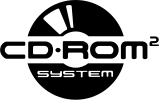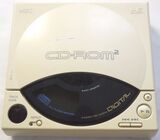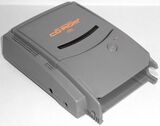Difference between revisions of "CD-ROM² systems"
From Sega Retro
Ccawley2011 (talk | contribs) (Created page with "{{ConsoleBob | | logo=CDROM2 logo.svg|200px]] | consoleimage=CDROM2.jpg | imgwidth= | consoleimage2=SuperCDROM2.jpg | imgwidth2= | name= | maker=NEC | distributor= | varia...") |
m (Text replacement - "| imgwidth= |" to "|") |
||
| (4 intermediate revisions by 4 users not shown) | |||
| Line 2: | Line 2: | ||
| | logo=CDROM2 logo.svg|200px]] | | | logo=CDROM2 logo.svg|200px]] | ||
| consoleimage=CDROM2.jpg | | consoleimage=CDROM2.jpg | ||
| − | |||
| consoleimage2=SuperCDROM2.jpg | | consoleimage2=SuperCDROM2.jpg | ||
| imgwidth2= | | imgwidth2= | ||
| name= | | name= | ||
| − | | maker=[[NEC]] | + | | maker=[[NEC Home Electronics]] |
| distributor= | | distributor= | ||
| variants= | | variants= | ||
| Line 21: | Line 20: | ||
}} | }} | ||
}} | }} | ||
| − | <section begin=intro />The ''CD-ROM² systems'' were [[NEC]]' | + | <section begin=intro />The '''CD-ROM² systems''' were [[NEC Home Electronics]]' attempt at extending the [[PC Engine]] to support CD-based media, similar to the [[Sega Mega CD]]'s relationship to the [[Sega Mega Drive]]. In North America this unit was released as the '''TurboGrafx-CD''' - no [[Sega]] games were released for the system in this region, so Sega Retro uses the Japanese model and naming scheme. In Japan, [[NEC Avenue]] released half a dozen ports of Sega arcade games for the system. |
| − | |||
| − | There are several types of CD-ROM² games, dictated by the amount of RAM the PC Engine system in use had. [[nec:CD-ROM²|CD-ROM²]] games simply use the resources of a standard PC Engine. [[nec:Super CD-ROM²|Super CD-ROM²]] (SCD) games require more RAM, and [[nec:Arcade CD-ROM²|Arcade CD-ROM²]] games (ACD) need even more. No Sega games were released on ACD format, though a couple used SCD. Japanese consumers could purchase special HuCards which added RAM to the setup, allowing for the more advanced games to be played. Sega did something similar with the [[Sega Saturn]], and its 1MB and 4MB RAM [[Extended RAM Cartridge]]s. | + | There are several types of CD-ROM² games, dictated by the amount of RAM the PC Engine system in use had. [[nec:CD-ROM²|CD-ROM²]] games simply use the resources of a standard PC Engine. [[nec:Super CD-ROM²|Super CD-ROM²]] (SCD) games require more RAM, and [[nec:Arcade CD-ROM²|Arcade CD-ROM²]] games (ACD) need even more. No Sega games were released on ACD format, though a couple used SCD. Japanese consumers could purchase special HuCards which added RAM to the setup, allowing for the more advanced games to be played. Sega did something similar with the [[Sega Saturn]], and its 1MB and 4MB RAM [[Extended RAM Cartridge]]s.<section end=intro /> |
==Sega support== | ==Sega support== | ||
{{TODO}} | {{TODO}} | ||
| − | ==List of Sega games for | + | ==List of Sega games for CD-ROM² systems== |
| + | ===CD-ROM²=== | ||
{{BulletPointGameList|category=CD-ROM² games}} | {{BulletPointGameList|category=CD-ROM² games}} | ||
| − | == | + | ===Super CD-ROM²=== |
{{BulletPointGameList|category=Super CD-ROM² games}} | {{BulletPointGameList|category=Super CD-ROM² games}} | ||
| + | |||
| + | ==Other CD-ROM² systems games also released for Sega systems== | ||
| + | ===CD-ROM²=== | ||
| + | {{NonSegaList|CDROM2}} | ||
| + | |||
| + | ===Super CD-ROM²=== | ||
| + | {{NonSegaList|SCDROM2}} | ||
| + | |||
| + | ===Arcade CD-ROM²=== | ||
| + | {{NonSegaList|ACDROM2}} | ||
==References== | ==References== | ||
Latest revision as of 03:27, 12 September 2023

| |||||||||||||||||||||||||
 
| |||||||||||||||||||||||||
| CD-ROM² systems | |||||||||||||||||||||||||
|---|---|---|---|---|---|---|---|---|---|---|---|---|---|---|---|---|---|---|---|---|---|---|---|---|---|
| Manufacturer: NEC Home Electronics | |||||||||||||||||||||||||
|
The CD-ROM² systems were NEC Home Electronics' attempt at extending the PC Engine to support CD-based media, similar to the Sega Mega CD's relationship to the Sega Mega Drive. In North America this unit was released as the TurboGrafx-CD - no Sega games were released for the system in this region, so Sega Retro uses the Japanese model and naming scheme. In Japan, NEC Avenue released half a dozen ports of Sega arcade games for the system.
There are several types of CD-ROM² games, dictated by the amount of RAM the PC Engine system in use had. CD-ROM² games simply use the resources of a standard PC Engine. Super CD-ROM² (SCD) games require more RAM, and Arcade CD-ROM² games (ACD) need even more. No Sega games were released on ACD format, though a couple used SCD. Japanese consumers could purchase special HuCards which added RAM to the setup, allowing for the more advanced games to be played. Sega did something similar with the Sega Saturn, and its 1MB and 4MB RAM Extended RAM Cartridges.
Contents
Sega support
| This task is unfinished This is a wiki task that requires more thought or peer review. An important issue that needs to be solved, which will appear at the top of Sega Retro:Todo until this message is removed. |
List of Sega games for CD-ROM² systems
CD-ROM²
- Altered Beast (1988)
- Golden Axe (1989)
Super CD-ROM²
- Bonanza Bros. (1990)
- Gain Ground (1988)
Other CD-ROM² systems games also released for Sega systems
CD-ROM²
- Burai: Hachigyoku no Yuushi Densetsu
- Capcom no Quiz Tonosama no Yabou
- Death Bringer
- Dragon's Eye Plus: Shanghai III
- Exile
- Hellfire
- Jantei Monogatari
- Master of Monsters
- Mega Schwarzschild
- Rainbow Islands: The Story of Bubble Bobble 2
- Shanghai II: Dragon's Eye
- Sherlock Holmes: Consulting Detective Vol. I
- Sherlock Holmes: Consulting Detective Vol. II
- Space Invaders
- Star Mobile
- Super Daisenryaku
- The Manhole
- The Space Adventure
- Valis III
- Where in the World is Carmen Sandiego?
- Wonder Boy III: Monster Lair
- Ys III: Wanderers from Ys
- Zero Wing
Super CD-ROM²
- Advanced V.G.
- Alshark
- Bakuden Unbalance Zone
- Best of the Best: Championship Karate
- Black Hole Assault
- Chiki Chiki Boys
- Cotton
- Darius II
- Double Dragon II: The Revenge
- Doukyuusei if
- Dragon Slayer: The Legend of Heroes
- Dragon Slayer: The Legend of Heroes II
- Faceball 2000
- Forgotten Worlds
- FX-Unit Yuki: The Henshin Engine
- Genghis Khan II: Clan of the Gray Wolf
- Hatsukoi Monogatari
- Kuusou Kagaku Sekai Gulliver Boy
- Langrisser
- Lemmings
- Linda³ Kanzenban
- Lords of Thunder
- Might and Magic III: Isles of Terra
- Motteke Tamago with Ganbare! Kamonohashi
- Nobunaga no Yabou: Bushou Fuuunroku
- Nobunaga's Ambition
- Popful Mail
- Princess Maker 2
- Psychic Detective Series Vol. 3: AÝA
- Psychic Detective Series Vol. 4: Orgel
- Puyo Puyo
- Puyo Puyo Tsuu
- R-Type
- Romance of the Three Kingdoms III: Dragon of Destiny
- Shadow of the Beast
- Shin Megami Tensei
- SimEarth
- Snatcher
- Sorcerian
- Sotsugyou II Neo Generation
- Sotsugyou S
- Steam-Heart's
- Super Real Mahjong PV
- Tanjou S: Debut
- Todd's Adventures in Slime World
- Valis: The Fantasm Soldier
Arcade CD-ROM²
References
NEC Retro has more information related to CD-ROM² systems
|
| Non-Sega consoles |
|---|
| Nintendo |
| Nintendo Entertainment System (1983) | Game Boy (1989) | Super Nintendo Entertainment System (1990) | Nintendo 64 (1996) | Game Boy Color (1998) | Game Boy Advance (2001) | Nintendo GameCube (2001) | Nintendo DS (2004) | Wii (2006) | Nintendo 3DS (2011) | Wii U (2012) | Nintendo Switch (2017) |
| Sony |
| PlayStation (1994) | PlayStation 2 (2000) | PlayStation Portable (2004) | PlayStation 3 (2006) | PlayStation Vita (2011) | PlayStation 4 (2013) | PlayStation 5 (2020) |
| Microsoft |
| Xbox (2001) | Xbox 360 (2005) | Xbox One (2013) | Xbox Series X (2020) |
| Mobile |
| iOS | Android | Windows Phone |
| Other |
| Atari 2600 (1977) | Intellivision (1979) | ColecoVision (1982) | Atari 5200 (1982) | PC Engine (1987) | CD-ROM² (1988) | Super CD-ROM² (1991) | R-Zone (1995) | Game.com (1997) | WonderSwan (1999) | Neo Geo Pocket Color (1999) | N-Gage (2003) | LeapFrog Didj (2008) | Stadia (2019) |
